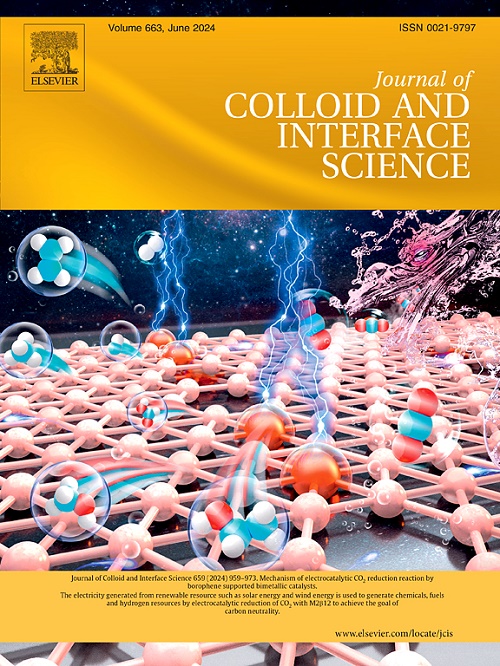锚定在磷改性碳氮平面上的铁基和镍基合金纳米颗粒可增强硝酸盐还原成氨的电化学效果。
IF 9.4
1区 化学
Q1 CHEMISTRY, PHYSICAL
引用次数: 0
摘要
锚定在碳氮平面(FeNi-CN)上的铁和镍纳米颗粒催化剂被认为是有望实现硝酸盐电化学还原成氨(ENO3RR)的潜在候选催化剂。然而,与氮原子配位的铁和镍位点的高 d 轨道能级往往会导致反应中间产物在活性位点上的吸附力过强,严重限制了催化性能的提高。本文成功制备了一种由限制在磷(P)修饰的碳氮平面内的 FeNi3 合金纳米粒子组成的催化剂 FeNi3@P-NC,P 在碳氮平面上诱导的电子撤回效应降低了 d 轨道能,优化了 FeNi 合金的 d 带中心,从而削弱了中间产物在金属-N 位点上的过强吸附,进而提高了 NO3RR 活性。所制备的 FeNi3@P-NC 催化剂具有优异的 NO3RR 性能,在碱性介质中,与可逆氢电极(vs. RHE)相比,-0.7 V 电压下的 NH3 产率(FENH3)为 93 ± 4.5 %,NH3 产率(YNH3)为 9633 ± 227.3 μg h-1 cm-2。重要的是,FeNi3@P-NC 还表现出卓越的催化稳定性和耐久性,在连续二十五次电化学循环以及在 100 mA cm-2 下连续电解 50 小时后仍能保持稳定。本文章由计算机程序翻译,如有差异,请以英文原文为准。

Iron and nickel based alloy nanoparticles anchored on phosphorus-modified carbon-nitrogen plane enhances electrochemical nitrate reduction to ammonia
The catalysts of iron and nickel nanoparticles anchored on carbon–nitrogen plane (FeNi-CN) are considered as the potential candidates for promising electrochemical nitrate reduction to ammonia (ENO3RR). However, the high d-orbital energy levels of iron and nickel sites coordinated with nitrogen atoms often lead to overly strong adsorption of reaction intermediates on active sites, severely limiting the improvement of catalytic performance. Herein, a catalyst FeNi3@P-NC consisting FeNi3 alloy nanoparticles confined in phosphorus (P)-modified carbon–nitrogen plane is successfully fabricated, where the electron withdrawal effect induced by P on the carbon–nitrogen plane decreases the d-orbital energy, and optimizes the d-band center of FeNi alloy, thus weakening the overly strong adsorption of intermediates at the metal-N sites and thereby improving NO3RR activity. The prepared FeNi3@P-NC catalyst exhibits exceptional NO3RR performance with a 93 ± 4.5 % Faradaic efficiency of NH3 production (FENH3) and a high NH3 yield rate (YNH3) of 9633 ± 227.3 μg h−1 cm−2 at −0.7 V versus Reversible Hydrogen Electrode (vs. RHE) under alkaline medium. Importantly, FeNi3@P-NC also demonstrates superior catalytic stability and durability, which maintains stability over twenty-five successive electrochemical cycles and for 50 h of continuous electrolysis at 100 mA cm−2.
求助全文
通过发布文献求助,成功后即可免费获取论文全文。
去求助
来源期刊
CiteScore
16.10
自引率
7.10%
发文量
2568
审稿时长
2 months
期刊介绍:
The Journal of Colloid and Interface Science publishes original research findings on the fundamental principles of colloid and interface science, as well as innovative applications in various fields. The criteria for publication include impact, quality, novelty, and originality.
Emphasis:
The journal emphasizes fundamental scientific innovation within the following categories:
A.Colloidal Materials and Nanomaterials
B.Soft Colloidal and Self-Assembly Systems
C.Adsorption, Catalysis, and Electrochemistry
D.Interfacial Processes, Capillarity, and Wetting
E.Biomaterials and Nanomedicine
F.Energy Conversion and Storage, and Environmental Technologies

 求助内容:
求助内容: 应助结果提醒方式:
应助结果提醒方式:


